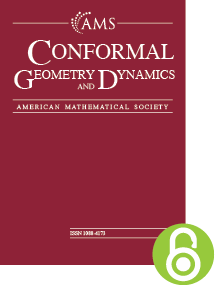Deformations of the modular group as a quasifuchsian correspondence
HTML articles powered by AMS MathViewer
- by Shaun Bullett
- Conform. Geom. Dyn. 14 (2010), 296-321
- DOI: https://doi.org/10.1090/S1088-4173-2010-00218-3
- Published electronically: November 18, 2010
- PDF | Request permission
Abstract:
When viewed as a $(2:2)$ holomorphic correspondence on the Riemann sphere, the modular group $PSL_2({\mathbb Z})$ has a moduli space ${\mathcal Q}$ of non-trivial deformations for which the limit set remains a topological circle. This space is analogous to a Bers slice of the deformation space of a Fuchsian group as a Kleinian group, but there are certain differences. A Bers slice contains a single quasiconformal conjugacy class of Kleinian groups: we show that for an open dense set of parameter values in ${\mathcal Q}$ the correspondence belongs to a single quasi-conformal conjugacy class, but that at a countable set ${\mathcal C}$ of isolated parameter values it satisfies an additional critical relation. We classify these relations, propose ‘pleating coordinates’ for ${\mathcal Q}$, and investigate how the correspondence degenerates on the boundary of ${\mathcal Q}$. In particular, we show that there is a point on the boundary of ${\mathcal Q}$ where the correspondence degenerates into a mating between $PSL_2(\mathbb Z)$ and the quadratic polynomial $z \to z^2+1/4$. A key ingredient in our analysis is a bijection between ${\mathcal Q}\setminus {\mathcal C}$ and an intermediate cover between the moduli space of the space of non-critical grand orbits of the correspondence, and its universal cover, the corresponding Teichmüller space.References
- S. Bullett, Matings in Holomorphic Dynamics, in Geometry of Riemann Surfaces, edited by Frederick P. Gardiner, Gabino Gonzalez Diez and Christos Kourouniotis, LMS Lecture Notes 368, CUP 2010, 88–119.
- Shaun Bullett and Peter Haïssinsky, Pinching holomorphic correspondences, Conform. Geom. Dyn. 11 (2007), 65–89. MR 2314243, DOI 10.1090/S1088-4173-07-00160-9
- S. R. Bullett and W. J. Harvey, Mating quadratic maps with Kleinian groups via quasiconformal surgery, Electron. Res. Announc. Amer. Math. Soc. 6 (2000), 21–30. MR 1751536, DOI 10.1090/S1079-6762-00-00076-7
- Shaun Bullett and Christopher Penrose, Mating quadratic maps with the modular group, Invent. Math. 115 (1994), no. 3, 483–511. MR 1262941, DOI 10.1007/BF01231770
- S. Bullett and C. Penrose, Regular and limit sets for holomorphic correspondences, Fund. Math. 167 (2001), no. 2, 111–171. MR 1816043, DOI 10.4064/fm167-2-2
- Linda Keen and Caroline Series, Pleating invariants for punctured torus groups, Topology 43 (2004), no. 2, 447–491. MR 2052972, DOI 10.1016/S0040-9383(03)00052-1
- R. Mañé, P. Sad, and D. Sullivan, On the dynamics of rational maps, Ann. Sci. École Norm. Sup. (4) 16 (1983), no. 2, 193–217. MR 732343, DOI 10.24033/asens.1446
- David Mumford, Caroline Series, and David Wright, Indra’s pearls, Cambridge University Press, New York, 2002. The vision of Felix Klein. MR 1913879, DOI 10.1017/CBO9781107050051.024
- M. Samarasinghe, Ph.D. thesis, Queen Mary University of London, 2008.
- Dennis P. Sullivan and William P. Thurston, Extending holomorphic motions, Acta Math. 157 (1986), no. 3-4, 243–257. MR 857674, DOI 10.1007/BF02392594
Bibliographic Information
- Shaun Bullett
- Affiliation: School of Mathematical Sciences, Queen Mary University of London, Mile End Road, London E1 4NS, United Kingdom
- Email: s.r.bullett@qmul.ac.uk
- Received by editor(s): July 7, 2010
- Published electronically: November 18, 2010
- Additional Notes: The author thanks the Heilbronn Institute, University of Bristol, for its support during the writing of this paper, and the Fields institute, Toronto, for providing an ideal environment for early work in March 2006, on the ideas presented here.
- © Copyright 2010
American Mathematical Society
The copyright for this article reverts to public domain 28 years after publication. - Journal: Conform. Geom. Dyn. 14 (2010), 296-321
- MSC (2010): Primary 37F05; Secondary 37F30
- DOI: https://doi.org/10.1090/S1088-4173-2010-00218-3
- MathSciNet review: 2738531


